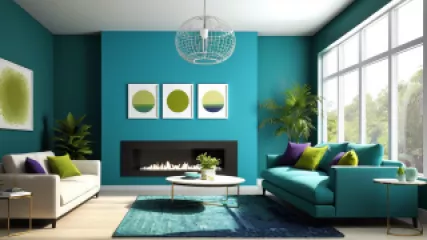Creating a Calming Home Environment with Colors
Creating a calming home environment is essential for promoting relaxation and well-being. One effective way to achieve this is through the use of colors in interior design. Color theory plays a significant role in understanding how different colors can affect our moods and emotions. By incorporating the right colors into your home, you can create a serene and peaceful atmosphere that promotes tranquility and harmony.
The Psychology of Color in Interiors
Before delving into the specific colors that can help create a calming home environment, let's explore the psychology of color in interiors. Colors have the power to evoke emotional responses and influence our mood, behavior, and overall well-being. Understanding the impact of colors can help you make informed decisions when choosing color schemes for your home.
Warm Colors:
Warm colors such as red, orange, and yellow are known for their stimulating and energizing effects. These colors can evoke feelings of warmth, excitement, and passion. While they may not be the best choice for creating a calming environment, they can be used strategically to add pops of energy or create focal points in certain areas of your home.
Cool Colors:
Cool colors like blue, green, and purple have a calming and soothing effect on our minds. They are often associated with nature, tranquility, and serenity. Cool colors can help lower blood pressure, reduce stress levels, and promote relaxation. These colors are ideal for creating a calming atmosphere in your home.
Colors and Mood in Interior Design
Now that we understand the psychological effects of colors, let's explore how different colors can be used to enhance the mood and atmosphere of your home.
1. Serene Blue:
Blue is often regarded as one of the most calming colors. It is associated with tranquility and can help promote a sense of relaxation. Light shades of blue, such as sky blue or baby blue, can create a serene and peaceful ambiance in bedrooms, bathrooms, or any area where you want to unwind. Blue is also known to have a cooling effect, making it an excellent choice for rooms with lots of natural light or in warmer climates.
2. Calming Green:
Green is another color that is closely connected to nature and has a calming influence on our minds. It symbolizes renewal, growth, and harmony. Incorporating shades of green, such as sage or mint, into your home can create a refreshing and tranquil atmosphere. Green is particularly suitable for living rooms, home offices, or any space where you want to foster a sense of balance and well-being.
3. Soothing Neutrals:
Neutral colors like beige, gray, and taupe can also contribute to a calming home environment. These colors create a sense of simplicity, elegance, and timelessness. Neutrals provide a neutral backdrop that allows other elements in your home, such as artwork or furniture, to stand out. They can be used as the primary color scheme or as a foundation to complement bolder accent colors.
4. Tranquil Purple:
Purple is often associated with spirituality, luxury, and relaxation. Light shades of purple, such as lavender or lilac, can create a serene and dreamy atmosphere in bedrooms or meditation spaces. Purple can also help stimulate creativity and promote a sense of tranquility. However, it's essential to use purple in moderation, as too much of it can be overwhelming.
5. Relaxing Earth Tones:
Earth tones, such as warm browns and soft yellows, can create a cozy and inviting atmosphere in your home. These colors are reminiscent of natural elements like sand, stone, and wood. Earth tones provide a grounding effect and can evoke a sense of stability and security. They are particularly suitable for living rooms, dining areas, or any space where you want to create a warm and welcoming environment.
Wellness through Interior Color Choices
Creating a calming home environment goes beyond just selecting the right colors. It also involves considering other factors that contribute to overall wellness. Here are a few additional tips to enhance your well-being:
1. Natural Light:
Maximize the use of natural light in your home. Sunlight has a positive impact on our mood and energy levels. Open curtains or blinds during the day to allow natural light to fill your space.
2. Decluttered Space:
A cluttered space can create a sense of chaos and stress. Keep your home organized and free of unnecessary clutter to promote a calm and peaceful environment.
3. Indoor Plants:
Bring nature indoors by incorporating houseplants into your space. Plants not only add aesthetic appeal but also improve air quality and create a sense of serenity.
4. Texture and Comfort:
Consider the texture and comfort of furniture and decor items. Soft textures, such as plush cushions or cozy blankets, can enhance the feeling of relaxation in your home.
5. Personal Touches:
Add personal touches that bring you joy and comfort. Display cherished photos, artwork, or sentimental objects that evoke positive emotions and create a sense of happiness.
The colors you choose for your home can have a profound impact on your overall well-being. By understanding the psychology of color and using it to your advantage, you can create a calming home environment that promotes relaxation and tranquility.Creating a Calming Home Environment with Colors - Dennis Murray






